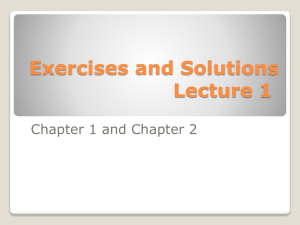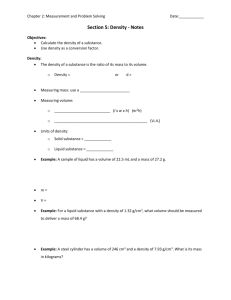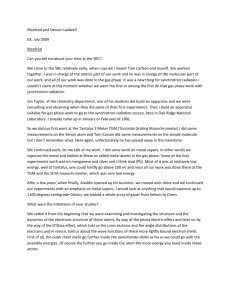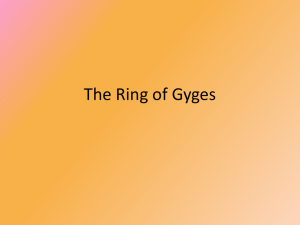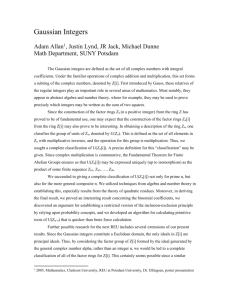Dan Wallace
advertisement
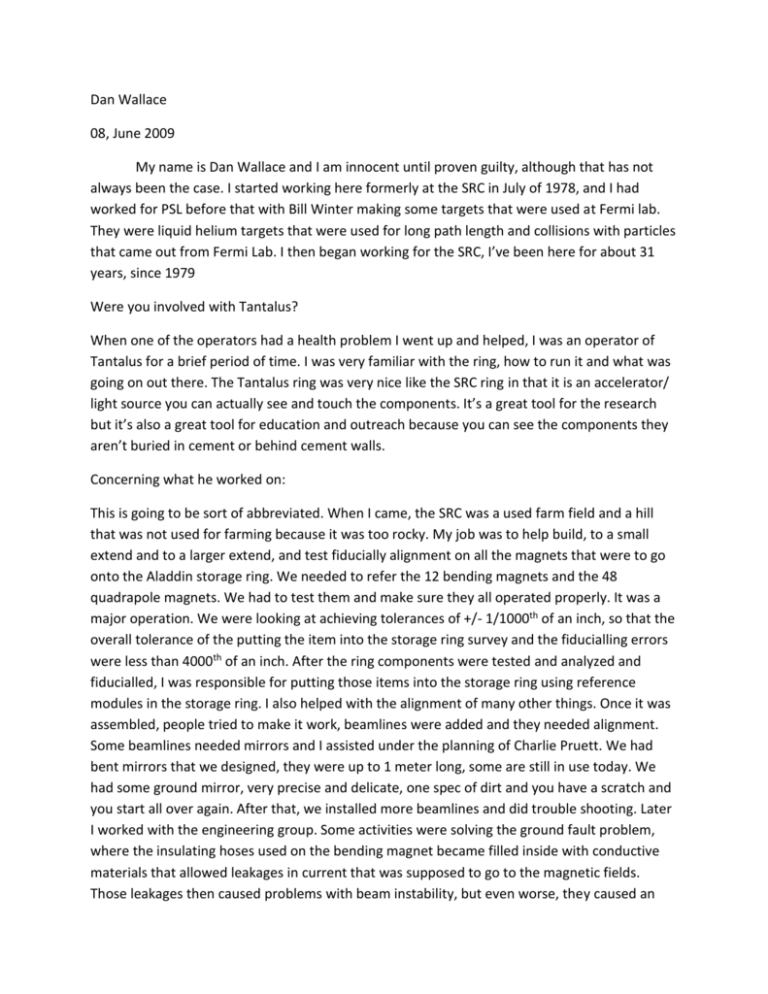
Dan Wallace 08, June 2009 My name is Dan Wallace and I am innocent until proven guilty, although that has not always been the case. I started working here formerly at the SRC in July of 1978, and I had worked for PSL before that with Bill Winter making some targets that were used at Fermi lab. They were liquid helium targets that were used for long path length and collisions with particles that came out from Fermi Lab. I then began working for the SRC, I’ve been here for about 31 years, since 1979 Were you involved with Tantalus? When one of the operators had a health problem I went up and helped, I was an operator of Tantalus for a brief period of time. I was very familiar with the ring, how to run it and what was going on out there. The Tantalus ring was very nice like the SRC ring in that it is an accelerator/ light source you can actually see and touch the components. It’s a great tool for the research but it’s also a great tool for education and outreach because you can see the components they aren’t buried in cement or behind cement walls. Concerning what he worked on: This is going to be sort of abbreviated. When I came, the SRC was a used farm field and a hill that was not used for farming because it was too rocky. My job was to help build, to a small extend and to a larger extend, and test fiducially alignment on all the magnets that were to go onto the Aladdin storage ring. We needed to refer the 12 bending magnets and the 48 quadrapole magnets. We had to test them and make sure they all operated properly. It was a major operation. We were looking at achieving tolerances of +/- 1/1000th of an inch, so that the overall tolerance of the putting the item into the storage ring survey and the fiducialling errors were less than 4000th of an inch. After the ring components were tested and analyzed and fiducialled, I was responsible for putting those items into the storage ring using reference modules in the storage ring. I also helped with the alignment of many other things. Once it was assembled, people tried to make it work, beamlines were added and they needed alignment. Some beamlines needed mirrors and I assisted under the planning of Charlie Pruett. We had bent mirrors that we designed, they were up to 1 meter long, some are still in use today. We had some ground mirror, very precise and delicate, one spec of dirt and you have a scratch and you start all over again. After that, we installed more beamlines and did trouble shooting. Later I worked with the engineering group. Some activities were solving the ground fault problem, where the insulating hoses used on the bending magnet became filled inside with conductive materials that allowed leakages in current that was supposed to go to the magnetic fields. Those leakages then caused problems with beam instability, but even worse, they caused an imbalance in the power supply so that the power supply dripped off randomly, once every 1-2 weeks. So I used my knowledge in physics and chemistry to devise a solution, which worked well. And other activities since then have been working with education and outreach group, that’s wonderful because I was originally trained in education. What was your solution? (to the leakage problem) I t was to analyze the, if you will, circuit that existed between the magnet power supply voltages, which in some cases would be as high as 140V, and the ground. The circuit was composed of pieces like copper wire as well as insulator objects like rubber hoses. After analyzing the circuit and examining the basics of electrolysis we were ripping apart various parts of the copper and doing deposition of copper inside the hoses. Most of that voltage was dropped across a very short diameter hose, what we did, instead of dropping it across the short hoses, we extended the voltage drop out to go across the small hoses and a longer hose. That was achieved by electrically floating or insulating a water supply manifold, insulating that from ground so that it could be at a higher voltage. The smaller the voltage drop across the two pieces, the less electrolysis occurred. It was one of these things, where there were very good people working in the area of physics, good people in field of operations. We had fire drills every time hoses would break. We had to guess where in the machine the groundfault was, take out the old hoses that had the old coating on the inside and put in new clean hoses. Those too would later become contaminated. This was a major improvement in operations, also in the area of having your power supplies properly balanced. The trick here was to look across crossdisciplines, the physics, electronics, as well as folding in some chemistry and putting that all into a package that was acceptable. There was a fair amount of, excuse the pun, a fair amount of non-electrical resistance to having any change. People were worried we would make a serious electrical shock hazard, and over the last 6-8 years that have been no problems. We insulated our pieces well, we put up precaution signs, we’ve done things correctly and it’s worked out nicely so far. You were involved in Aladdin’s construction? When the building was going up, I was down in the pit with the construction people getting some reference marks established as to where the center of the ring would be. Also, getting monuments established for surveying. This was all quite amazing to a young scientist who had most of his experience in classrooms and teaching. Can you talk about when NSF cut Aladdin’s funding over the lack of current? The business of controlling tiny electrons and getting them to do what you want them to do, and steering them and dealing with 12 bending magnets and 48 quadrapoles was not a simple task. At that time we did not have computers that were as functional as today, things were slower and we didn’t have diagnostics tools such as scripts and programs. We started out with a challenging problem, to the best of my knowledge, the alignment of the ring went well, but some of the components on the ring that were on the upper floor were wiggling in small amounts. This was due to some errors in the design of the floor. Also, some things changed because of some weight and loading changes that I was told were non-important, the chief engineer did a nice job on a lot of things especially the heating and cooling. But some basic things on floor loading he didn’t catch and had to be re-done. One of the main problems was the inflector, which is the main switching unit for taking the light from the microtron and putting into the storage ring, the inflector had been carefully surveyed, put into position, the entrance aperature was right where it was supposed to be, but somehow the engineering group when tightening it down, allowed that to slip. Since it was canteliever controlled, gravity took controlled and affected injection. The microtron beam was strong but it was difficult getting through the copper wire and into the entrance hole (the septum). Once there was some beam in the machine, there were ions that were being made and trapped. Those scattered the electrons and decreased beam lifetime. To put all of this in perspective, there were some simple mistakes such as the misplaced septum, but also, we were on the cutting edge, we were doing some early work on ion trapping and installing clearing electrodes. In the end, the clearing electrodes solved a lot of our difficulties. We eventually achieved the currents we hoped to achieve. Once we had the ring functioning we eventually upgraded it with a new latus that allowed us to have a more compact beam, we also now have better computers and diagnostic tools. Dave Lynch mentioned when Aladdin was running at .1mA and 10mA. Was that the period before all those upgrades you mentioned? I do not know exactly what currents were where. While this happened I was not working with the ring, the accelerator guys were doing that. The main problem was that we had clearing and alignment problems. There may have been other things, I don’t know just where in the sequence that happened. Walt Tryceziak should be able to clear that up. I worked for Walt when I was doing alignment work, he was helpful at educating me. After the ring was up and together, they didn’t need my services and I then worked with Charlie Pruett. In 1983, an article mentions the beamlines installed. Can you tell me about what dictated the development of the beamlines? I’m not a planner in this area but I have an understanding of what was going on. The first beamlines that were put onto Aladdin were actually from Tantalus. They were either tested on Tantalus or they were used and designed on Tantalus such as: Stainless Steel Saya Mark V Grasshopper Mark II Grasshopper Those were some of the early beamlines I worked with. While all of that was happening there were some newer fancy beamlines like 6m TGM 4m NIM (Normal incident monochrometer) Those were being designed, assembled, and tested. What motivated the development of beamlines, user input? Each of these beamlines uses a different process, different resolutions, they have different throughputs and they’re designed for different energy ranges. The choice of what was put on was dictated by what we already had, sometimes it was a matter of shifting to a different grating for different blazes. The decisions concerning beamlines were made mainly by the director and instrument group/optics group leaders with significant input from the user community. We attempted to make sure the users were getting the tools they needed for the research, and that’s what these machines were. I asked because you had mentioned that this was pretty cutting edge stuff and there was no manual or guidebook. It’s interesting see what forces brought on Aladdin. There’s whole other invisible part to this and that would be the, if you will, “virtual contributions,” because Aladdin was not operating alone there were other people that got their institutions who designed things, writing papers of what worked and didn’t. We were keeping up to date very well from other papers that helped us design our equipment. To use a biological term, there was a lot of cross-fertilization between different laboratories especially between Brookhaven and the SRC. There was also a fair amount of competition because there were times we were vying for the same funds, so at times it was a rather strange dance, but it appeared to work, Brookhaven is still going and we’re still going. Any other stories? SRC has been and remains to be a unique place to work and do science. One of the really wonderful aspects is the many people from the US, Europe, and Asia who have come to the lab and made their contributions. I have met some wonderful people, there is good diversity in interests, skills, and talent here. They are for the most part good at sharing ideas and helping and even though some are a little quirky, they’re wonderful people. Any last thoughts? It’s great seeing this facility evolve. It has a lot to offer, the present and future staff as well as the surrounding communities. It’s my hope that this laboratory continues moving forward doing whatever it can with the tools it has.

